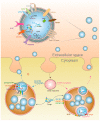The Role of Exosomes in the Crosstalk between Adipocytes and Liver Cancer Cells
- PMID: 32872417
- PMCID: PMC7563540
- DOI: 10.3390/cells9091988
The Role of Exosomes in the Crosstalk between Adipocytes and Liver Cancer Cells
Abstract
Exosomes are membrane-bound extracellular vesicles (EVs) that transport bioactive materials between cells and organs. The cargo delivered by exosomes can alter a wide range of cellular responses in recipient cells and play an important pathophysiological role in human cancers. In hepatocellular carcinoma (HCC), for example, adipocyte- and tumor-secreted factors contained in exosomes contribute to the creation of a chronic inflammatory state, which contributes to disease progression. The exosome-mediated crosstalk between adipocytes and liver cancer cells is a key aspect of a dynamic tumor microenvironment. In this review, we summarize the role of increased adiposity and the role of adipocyte-derived exosomes (AdExos) and HCC-derived exosomes (HCCExos) in the modulation of HCC progression. We also discuss recent advances regarding how malignant cells interact with the surrounding adipose tissue and employ exosomes to promote a more aggressive phenotype.
Keywords: adipocyte exosomes; adipocytes; cell signaling; exosomal cargo; exosomes; hepatocellular carcinoma; obesity.
Conflict of interest statement
The authors declare no conflict of interest.
Figures



References
Publication types
MeSH terms
Grants and funding
LinkOut - more resources
Full Text Sources
Medical

